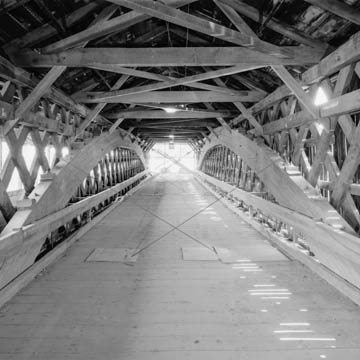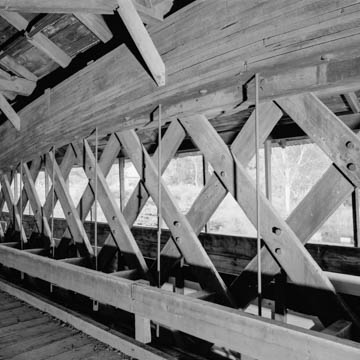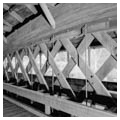The Bath-Haverhill Bridge survives as the oldest Ithiel Town lattice truss bridge in the United States and one of the oldest covered bridges of any design to survive in the nation. Architect Town of New Haven, Connecticut, patented the bridge truss that bears his name in 1820. One of the advantages of Town’s patent was its use of uniform, sawn planks, pinned together in a repetitive lattice pattern to create a truss as long as might be needed. Proponents of this simplified method of bridge construction reportedly described Town trusses as capable of being “built by the mile and cut off by the yard.” The Bath-Haverhill Bridge demonstrates this aphorism; the ends of the trusses do not terminate at vertical posts, but are simply “cut off,” and the projecting ends of the diagonal 3 x 10–inch white pine lattice members are not attached to anything. One remarkable feature of the Bath-Haverhill Bridge is the degree to which original truss planking has survived throughout the structure. Except where the upstream truss was damaged by a floating tree in a 1927 flood and where truss members were replaced during rehabilitation in 2008, the planks show the distinctive marks of a reciprocating water-powered sawmill, probably Alcott’s sawmill, which stood nearby in 1829. The adjacent towns of Haverhill and Bath evidently failed to pay the required royalty for using Town’s patented design for the bridge (which measures 256 feet in total length), and the Haverhill town records show a payment of $84 as Haverhill’s share of the penalty in 1832. Increasing motor traffic required the two towns to strengthen the bridge by adding laminated wooden arches in 1921–1922; they added a sidewalk on the upstream side at about the same time. After carrying traffic for 180 years, the bridge was bypassed when an adjacent steel bridge was built in 1998–1999. The bridge was rehabilitated for pedestrian use in 2008.
You are here
Bath-Haverhill Bridge
1829. Ammonoosuc St. over the Ammonoosuc River
Coordinator:
Bryant F. Tolles Jr. and James L. Garvin
If SAH Archipedia has been useful to you, please consider supporting it.
SAH Archipedia tells the story of the United States through its buildings, landscapes, and cities. This freely available resource empowers the public with authoritative knowledge that deepens their understanding and appreciation of the built environment. But the Society of Architectural Historians, which created SAH Archipedia with University of Virginia Press, needs your support to maintain the high-caliber research, writing, photography, cartography, editing, design, and programming that make SAH Archipedia a trusted online resource available to all who value the history of place, heritage tourism, and learning.















